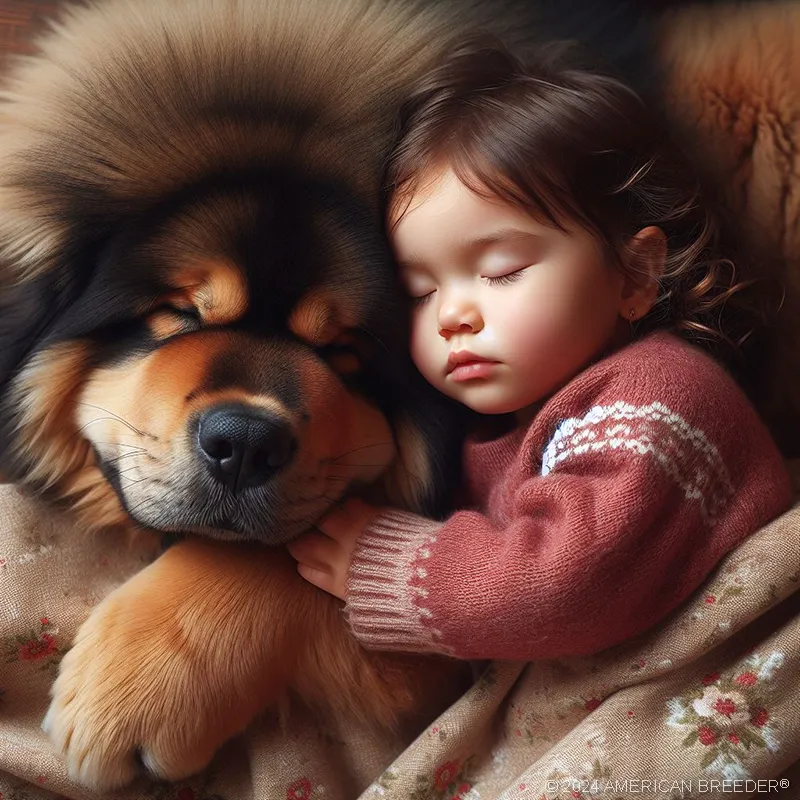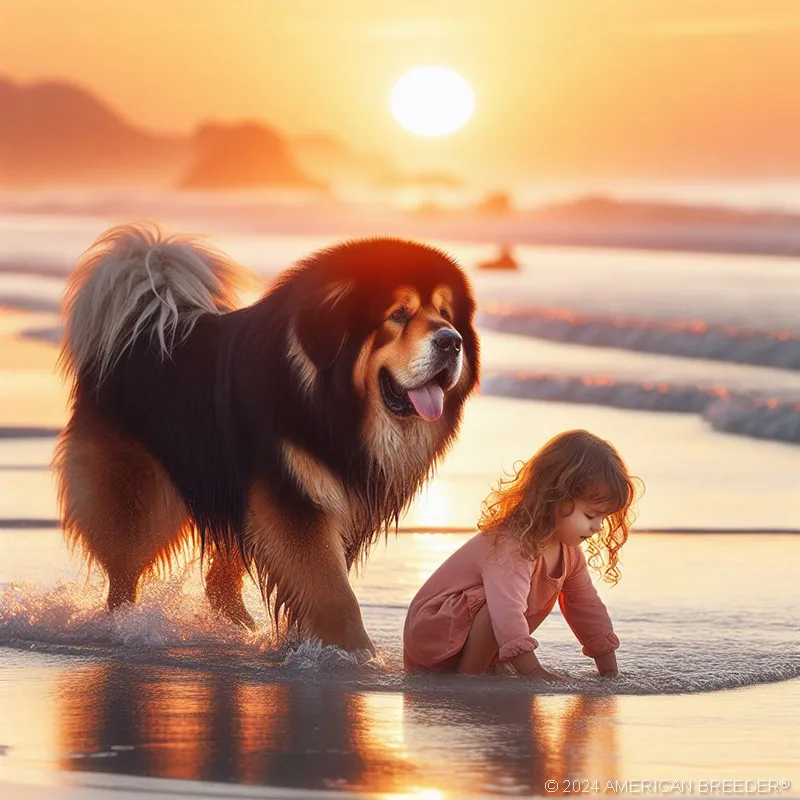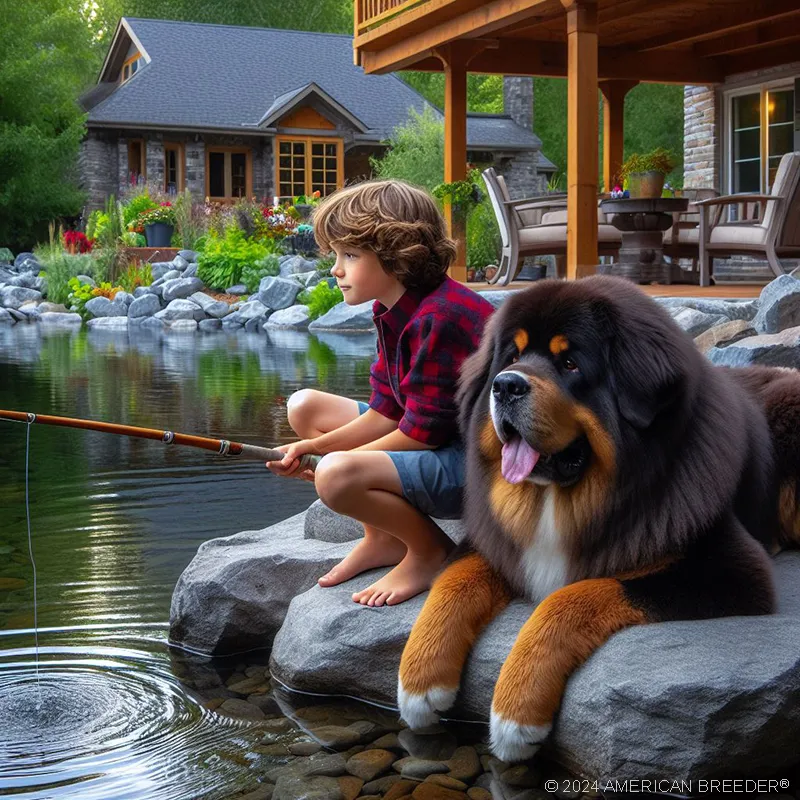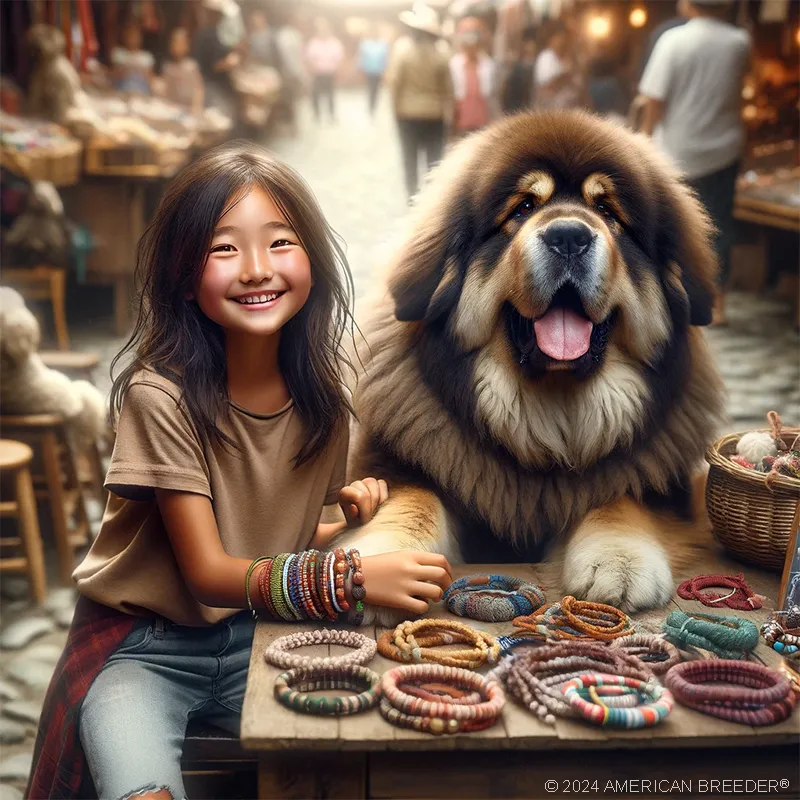The Ultimate Companion for Tibetan Mastiff Dog Lovers
 Welcome to the definitive guide to the Tibetan Mastiff, a remarkable breed steeped in history, strength, and loyalty. This comprehensive resource aims to provide you with an in-depth understanding of every facet of the Tibetan Mastiff's attributes, history, care, and significance. Whether you're a seasoned enthusiast or a novice, this guide will be your compass to navigate the world of this majestic breed.
Welcome to the definitive guide to the Tibetan Mastiff, a remarkable breed steeped in history, strength, and loyalty. This comprehensive resource aims to provide you with an in-depth understanding of every facet of the Tibetan Mastiff's attributes, history, care, and significance. Whether you're a seasoned enthusiast or a novice, this guide will be your compass to navigate the world of this majestic breed.
Introduction
Embracing the Majesty of the Tibetan Mastiff
The Tibetan Mastiff, also known as the "Dok-Khyi," is an ancient breed with a rich heritage dating back thousands of years. Originating from the Himalayas, these dogs served as guardians of livestock and monasteries, fostering a bond of trust with humans. Their imposing stature, thick coat, and protective instincts are some of the defining traits that have earned them a special place in the hearts of dog lovers worldwide.
Considerations Before Choosing a Tibetan Mastiff
Before welcoming a Tibetan Mastiff into your home, it's crucial to consider their size, temperament, and exercise needs. These dogs are known for their independent nature and protective instincts, making early socialization and training imperative. While their loyalty and devotion are unwavering, they may not always be the best fit for families with small children or limited space. Additionally, their impressive size requires a dedicated commitment to exercise, mental stimulation, and grooming.
Interesting and Fun Facts about the Tibetan Mastiff
Other Names and Nicknames: The Tibetan Mastiff is known by various names, including "Do-Khyi" in Tibetan, which translates to "home guard." They've earned nicknames like "Lion Dog" due to their majestic appearance and "Bear Dog" for their impressive size and protective nature.
Breed Background and History: Guardians of the Himalayas
Origin and Development of the Tibetan Mastiff
The Tibetan Mastiff's origin can be traced to the remote Himalayan region, where they evolved to thrive in harsh conditions. Their ancestors were bred for specific traits, such as a thick double coat that protected them from extreme cold. Over generations, their role as guardians of livestock and monasteries solidified their loyalty, independence, and protective instincts.
Historical Significance or Cultural Relevance
These dogs held a revered place in Tibetan culture and society. Their presence in monasteries and nomadic communities contributed to the preservation of livestock and the safety of inhabitants. The Tibetan Mastiff's role was not only functional but also symbolic, embodying protection and spirituality.
 Purpose or Original Use of the Tibetan Mastiff
Purpose or Original Use of the Tibetan Mastiff
The Tibetan Mastiff's primary purpose was to protect livestock from predators like wolves, leopards, and bears. Their imposing size, booming bark, and unwavering dedication made them invaluable guardians. Beyond their protective role, they were also entrusted with safeguarding monasteries, adding a spiritual dimension to their significance.
Kennel Clubs and Recognition
Various kennel clubs recognize the Tibetan Mastiff, including the American Kennel Club (AKC) and the United Kennel Club (UKC). The AKC officially recognized the breed in 2007, placing it in the Working Group. This recognition has increased awareness of the breed's unique attributes and capabilities.
Appearance: Majestic and Powerful
Size, Weight, and Physical Appearance
Tibetan Mastiffs are impressively large dogs, with males weighing between 90 to 150 pounds (41 to 68 kg) and standing around 26 to 30 inches (66 to 76 cm) at the shoulder. Females are slightly smaller, weighing between 70 to 120 pounds (32 to 54 kg) and standing around 24 to 28 inches (61 to 71 cm) at the shoulder.
Coat Type, Color Variations, and Patterns
The breed's dense double coat consists of a soft, insulating undercoat and a weather-resistant outer coat. Tibetan Mastiffs come in a variety of coat colors, including black, blue, brown, and gold, often with a range of shades and patterns. Their coat serves as protection against the harsh climate of their Himalayan origins.
Distinctive Features or Markings
One of the most striking features of the Tibetan Mastiff is their imposing presence. Their large head is characterized by a strong muzzle, deep-set dark eyes, and a black nose. A distinct mane-like ruff of fur around the neck adds to their regal appearance, and their bushy tail curls over their back.
Average Litter Size for Tibetan Mastiffs
Tibetan Mastiffs generally have a moderate litter size, with the average ranging from 6 to 12 puppies. However, larger litters are not uncommon, and the nurturing nature of the breed's history as protectors and guardians translates into their role as devoted parents.
Temperament and Personality: Noble Protectors
Typical Temperament Traits and Behavior Tendencies
Tibetan Mastiffs are renowned for their independent and protective nature. They are loyal, devoted, and often reserved with strangers, embodying a sense of dignity. Their watchful demeanor makes them excellent guardians, and their deep bond with their family fosters a strong sense of loyalty.
 Energy Levels and Activity Requirements
Energy Levels and Activity Requirements
While they may have a calm disposition, Tibetan Mastiffs are not couch potatoes. Regular exercise is essential to maintain their physical health and mental well-being. Engaging them in activities that stimulate their instincts, such as scent work or interactive toys, is a great way to keep them engaged and content.
Compatibility with Different Lifestyles and Family Dynamics
Tibetan Mastiffs thrive in homes where their protective instincts are valued and respected. They are well-suited for families willing to invest time in training, socialization, and grooming. While they may not be the best choice for first-time dog owners, their loyalty and companionship make them a rewarding choice for experienced individuals or families.
List of Typical Behavior Issues
Aggression and Biting: Due to their protective nature, Tibetan Mastiffs may exhibit aggression towards strangers or perceived threats. Proper training and socialization from an early age are crucial to manage this behavior.
Excessive Barking: Alert and watchful, Tibetan Mastiffs have a tendency to bark, especially in response to unfamiliar noises. Teaching them when it's appropriate to bark can help control excessive noise.
Digging Behavior: Their digging instinct may arise from their history as protectors of livestock. Providing designated digging areas and ample exercise can help manage this behavior.
Separation Anxiety: Tibetan Mastiffs are highly attached to their families and may experience separation anxiety when left alone for extended periods. Gradual training and acclimatization to alone time can alleviate this issue.
Resource Guarding: Their protective nature can extend to resources like food, toys, or space. Early training to promote positive behavior around resources is essential.
Fear and Phobias: Tibetan Mastiffs may develop fears of certain stimuli due to their sensitive nature. Gradual desensitization and positive reinforcement can help alleviate these fears.
Trainability and Intelligence: Cultivating Obedience and Trust
 While Tibetan Mastiffs possess an independent streak, they are intelligent dogs capable of learning and following commands. However, their independent nature can sometimes lead to a selective response to commands, especially if they don't see the purpose behind them. Positive reinforcement techniques, such as treats and praise, work best when training a Tibetan Mastiff.
While Tibetan Mastiffs possess an independent streak, they are intelligent dogs capable of learning and following commands. However, their independent nature can sometimes lead to a selective response to commands, especially if they don't see the purpose behind them. Positive reinforcement techniques, such as treats and praise, work best when training a Tibetan Mastiff.
Willingness to Please Their Owner
Tibetan Mastiffs have a strong sense of loyalty and often strive to please their owners, particularly those they have formed a close bond with. Establishing a sense of trust and mutual respect is essential in motivating them to cooperate during training sessions.
Intelligence and Problem-Solving Abilities
These dogs possess a keen intelligence honed through generations of adapting to their challenging environment. Their problem-solving abilities can manifest in creative ways, such as finding solutions to escape from enclosed spaces or retrieve a desired object. Mental stimulation activities that challenge their intellect are beneficial for their overall well-being.
Recommended Training Approaches and Techniques
Training a Tibetan Mastiff requires patience, consistency, and a gentle yet firm approach. Positive reinforcement methods, such as rewarding desired behaviors and ignoring undesirable ones, yield the best results. Early socialization with other dogs, people, and various situations will help them become well-rounded adults.
Training or Skills Best Suited for Tibetan Mastiffs
Tibetan Mastiffs excel in roles that align with their guardian and protector heritage. Their alertness and strong instincts make them excellent candidates for roles such as therapy dogs, search and rescue dogs, and even livestock guardians. Advanced training in obedience and off-leash commands can further hone their skills.
Practical Considerations: Nurturing a Lifetime Bond
Size of Sleeping Quarters Depending on Size
Due to their substantial size, Tibetan Mastiffs require ample space for comfortable rest and sleep. Providing a cozy, well-cushioned dog bed in a quiet corner of your home ensures they have a dedicated spot for relaxation.
Typical Annual Veterinary Cost
Tibetan Mastiffs benefit from regular veterinary care to ensure their health and well-being. Annual check-ups, vaccinations, preventive treatments, and potential health screenings contribute to their overall quality of life. Budgeting for veterinary expenses is crucial to provide the best care for your furry friend.
 Type of Grooming and Annual Cost
Type of Grooming and Annual Cost
Grooming needs vary based on the Tibetan Mastiff's coat type. Long-haired individuals require more frequent brushing to prevent matting and manage shedding. While professional grooming may be necessary for certain occasions, regular brushing at home can significantly reduce grooming costs.
Daily Exercise Needs and Requirements
Daily exercise is essential to keep Tibetan Mastiffs physically and mentally fit. Engage them in activities like brisk walks, playtime, and interactive games that stimulate their senses. Adequate exercise reduces the risk of obesity and enhances their overall well-being.
Level of Playfulness
Tibetan Mastiffs possess a playful side beneath their dignified demeanor. They enjoy play sessions that involve mental stimulation and interaction with their owners. Engaging in games like fetch, puzzle toys, and hide-and-seek provides a balance between mental and physical activity.
Affection Level and Desired Attention
While they may not display affection in the same way as some breeds, Tibetan Mastiffs are deeply attached to their families. They demonstrate loyalty and devotion through their protective nature and strong bond. Earning their trust and respecting their need for personal space fosters a healthy relationship.
Friendliness Toward Strangers
Tibetan Mastiffs tend to be reserved and cautious around strangers. Early socialization and positive interactions during puppyhood can help them become more comfortable in various social situations.
Grooming Needs and Frequency
Brushing: Regular brushing helps prevent tangles and keeps their coat healthy. Long-haired Tibetan Mastiffs benefit from daily brushing, while shorter-haired ones can be brushed a few times a week.
Bathing: Bathing should be done as needed, usually every two to three months or when they become dirty. Use a dog-specific shampoo to maintain their coat's health.
Nail Trimming: Regular nail trimming prevents discomfort and maintains their paw health. Aim to trim their nails every few weeks or as needed.
Ear Cleaning: Cleaning their ears regularly with a dog-approved ear cleaner helps prevent infections and wax buildup.
Feeding Requirements and Dietary Considerations
Portion Sizes: Portion sizes depend on factors like age, weight, activity level, and metabolism. Consult your veterinarian to determine the appropriate portion size for your Tibetan Mastiff.
Feeding Schedule: Divide their daily food intake into two or three meals to aid digestion and prevent bloating.
Recommended Dog Food Brands/Types: Choose high-quality dog food formulated for large breeds. Look for a balanced diet that provides the necessary nutrients for their growth and health.
Treats and Dietary Restrictions: Treats should be given in moderation and used for training or as rewards. Avoid human foods that may be toxic to dogs, such as chocolate, grapes, and onions.
Health and Care: Nurturing Well-Being
 Common Health Issues or Predispositions of Tibetan Mastiffs
Common Health Issues or Predispositions of Tibetan Mastiffs
Tibetan Mastiffs are generally healthy dogs, but like all breeds, they can be prone to certain health issues. Common concerns include hip dysplasia, elbow dysplasia, bloat (gastric torsion), and hypothyroidism. Regular veterinary check-ups and adhering to preventive care measures can help mitigate these risks.
Allergies and Specific Dietary Considerations
Some Tibetan Mastiffs may develop allergies, particularly food allergies or sensitivities. It's important to monitor their diet and consult a veterinarian if you notice signs of itching, skin irritation, or gastrointestinal upset. Switching to hypoallergenic or limited ingredient diets may be recommended.
Lifespan and Longevity Expectations
Tibetan Mastiffs typically have a lifespan of around 10 to 14 years. Providing a well-balanced diet, regular exercise, preventive healthcare, and a loving environment contribute to their longevity. Responsible breeding practices also play a role in maintaining the breed's overall health.
Grooming Requirements Based on Coat Type and Size
Grooming routines should be tailored to your Tibetan Mastiff's specific coat type. Long-haired individuals require more attention to prevent matting, while shorter-haired ones benefit from regular brushing to maintain a healthy coat. Regular grooming sessions not only keep them looking their best but also provide opportunities for bonding.
Exercise Needs and Recommendations for Physical and Mental Stimulation
Tibetan Mastiffs thrive with both physical and mental stimulation. Regular exercise helps prevent obesity and maintains their overall health. Engage them in activities like long walks, playtime, and interactive games that challenge their problem-solving abilities. Mental enrichment, such as puzzle toys and scent work, keeps their minds sharp and satisfied.
Nutrition and Feeding Guidelines
Balanced nutrition is essential for the well-being of Tibetan Mastiffs. High-quality commercial dog food that meets their nutritional requirements is recommended. Consult with your veterinarian to determine the appropriate portion sizes and feeding schedule based on your dog's age, weight, and activity level.
Vaccination Schedule and Preventive Care
Core Vaccines: Core vaccines, including rabies, distemper, parvovirus, and adenovirus, are essential to protect your Tibetan Mastiff from serious diseases. Follow your veterinarian's recommended vaccination schedule.
Non-Core Vaccines: Depending on your dog's lifestyle and location, additional vaccines such as leptospirosis and Bordetella may be recommended.
Flea and Tick Prevention: Regular use of flea and tick preventives is crucial to protect your dog from parasites. Consult your veterinarian for safe and effective preventive options.
Heartworm Prevention: Administer monthly heartworm preventives to protect your dog from this potentially fatal parasitic infection transmitted by mosquitoes.
Regular Health Check-ups and Vet Visits
Routine veterinary check-ups are essential for monitoring your Tibetan Mastiff's overall health. Regular examinations, dental care, and preventive treatments contribute to their well-being and longevity.
Signs of Potential Health Problems and When to Seek Veterinary Attention
As a responsible owner, it's important to be vigilant for signs of potential health issues. If you notice changes in your Tibetan Mastiff's behavior, appetite, energy levels, or physical appearance, consult your veterinarian promptly for a thorough evaluation.
Socialization and Compatibility: Building Bonds
 Interaction with Children, Other Pets, and Strangers
Interaction with Children, Other Pets, and Strangers
Proper socialization during puppyhood is key to ensuring your Tibetan Mastiff is comfortable around children, other pets, and strangers. Early positive experiences with various people, animals, and environments contribute to their well-rounded behavior.
Socialization Needs and Tips for Proper Socialization
Exposing your Tibetan Mastiff to a variety of experiences, sights, sounds, and smells during their early months is essential for fostering a well-adjusted adult dog. Controlled introductions to new people, places, and situations help prevent fear or anxiety later in life.
Precautions or Considerations for Multi-Dog Households
Tibetan Mastiffs can coexist with other dogs if introduced properly and given enough space. Supervised interactions and gradual introductions are recommended to prevent conflicts and establish harmonious relationships.
Level of Ease When It Comes to Training Tibetan Mastiffs
Training a Tibetan Mastiff requires patience, consistency, and positive reinforcement. Their independent nature can sometimes make them appear stubborn, but they respond well to reward-based training methods. Training sessions should be short, engaging, and enjoyable for both you and your dog.
Playtime and Exercise with Other Dogs or Pets
Tibetan Mastiffs can enjoy playtime and companionship with other dogs or pets, provided they are introduced gradually and positively. Their guardian instincts may lead them to be protective, but proper socialization and training can help them navigate these interactions.
Dog-Friendly Activities and Outings
Engaging in dog-friendly activities and outings can be enriching for Tibetan Mastiffs. Long walks, hikes, trips to the dog park, and interactive games offer opportunities for mental and physical stimulation. Remember to consider their individual preferences and needs when planning outings.
Living Arrangements and Environment: Tailoring Their Space
 Suitability for Different Living Arrangements
Suitability for Different Living Arrangements
Tibetan Mastiffs are adaptable to various living arrangements, including both houses with yards and apartments. However, their exercise needs and size should be considered when choosing the most suitable living space.
Space Requirements and Exercise Options
While Tibetan Mastiffs can adapt to smaller spaces, they benefit from a home with sufficient room for movement. Regular exercise, outdoor playtime, and mental stimulation are vital regardless of the living arrangement.
Climate Considerations and Adaptability
These dogs are well-suited for cold climates, thanks to their thick double coat. In warmer climates, provide shaded areas and access to fresh water to prevent overheating. Be mindful of their susceptibility to heat due to their coat, size, and origins.
Recommended Yard Size for Tibetan Mastiffs
A spacious yard allows Tibetan Mastiffs to move freely and engage in play and exploration. Fencing should be secure and tall enough to prevent escapes, as these dogs may be tempted to roam if not properly contained.
Ideal Living Conditions and Environment
Tibetan Mastiffs thrive in homes where they are considered part of the family and their guardian instincts are valued. An environment that provides both mental and physical stimulation, along with ample opportunities for bonding, aligns with their needs and preferences.
Stimulation for Mind and Body
Mental Enrichment: Engage your Tibetan Mastiff's intellect through interactive toys, puzzle games, and scent work. These activities keep them mentally sharp and prevent boredom.
Physical Activity: Regular exercise is essential for maintaining their health and preventing obesity. Long walks, playtime, and activities that tap into their instincts, like agility courses, provide well-rounded stimulation.
Social Interaction: Regular interactions with family members, other dogs, and new experiences enhance their social skills and prevent behavioral issues.
Creating a Comfortable Indoor Space
Cozy Resting Areas: Provide comfortable beds or mats in quiet corners where your Tibetan Mastiff can relax and unwind.
Interactive Toys: Use puzzle toys and interactive feeders to engage their minds and alleviate boredom.
Safe Spaces: Designate a quiet, private space where they can retreat when they need a break from activity.
Outdoor Space and Safety Measures
Secure Fencing: Ensure your yard has secure, tall fencing to prevent escapes, as Tibetan Mastiffs may be inclined to explore.
Shade and Water: Provide shaded areas and fresh water to keep them comfortable in warm weather.
Supervised Playtime: While they can enjoy outdoor play, supervision is necessary to prevent encounters with wildlife or potential dangers.
Becoming a Tibetan Mastiff Advocate: Preserving the Legacy
 Promoting Responsible Ownership and Breed Advocacy
Promoting Responsible Ownership and Breed Advocacy
As a guardian of a Tibetan Mastiff, you become an advocate for responsible ownership. Share your knowledge with others and promote the breed's unique qualities, history, and care requirements. Encourage responsible breeding practices and ethical treatment of these majestic dogs.
Supporting Rescue and Adoption Efforts
Consider adopting a Tibetan Mastiff from a reputable rescue organization if you're looking to welcome one into your home. Rescuing a dog provides a second chance at a loving home while supporting efforts to provide care for abandoned or neglected individuals.
Participating in Breed-Specific Activities and Organizations
Engage with breed clubs, events, and organizations dedicated to the welfare of Tibetan Mastiffs. These forums offer opportunities to connect with fellow enthusiasts, share experiences, and contribute to breed preservation.
Educating Others About the Breed's Unique Attributes
By educating others about the Tibetan Mastiff's history, characteristics, and care needs, you contribute to the breed's recognition and preservation. Dispel myths and misconceptions to foster a better understanding of these noble dogs.
Conclusion: A Lifelong Journey with the Tibetan Mastiff
The journey with a Tibetan Mastiff is one of mutual respect, trust, and companionship. Their regal presence, protective nature, and rich history make them a breed like no other. From their origins as Himalayan guardians to their role as beloved family members, Tibetan Mastiffs enrich our lives with their loyalty, devotion, and unique qualities. As you embark on this remarkable journey, armed with knowledge and a deep appreciation for their heritage, you'll find yourself embraced by the enduring legacy of the Tibetan Mastiff—a true testament to the bond between humans and their faithful canine companions.
Tibetan Mastiff Dog Quick Reference Guide
 Breed Background: Origin: Tibet | Breed Purpose: Guarding Livestock & Property | AKC Class: Working | Year Recognized by AKC: 2007
Breed Background: Origin: Tibet | Breed Purpose: Guarding Livestock & Property | AKC Class: Working | Year Recognized by AKC: 2007
Appearance: Size: Large | Weight: 90-150 lbs | Coat Type: Double Coat | Colors & Patterns: Various (Black, Brown, Blue, Golden, Cream) | Distinctive Features: Lion's Mane, Regal Appearance
Temperament: Energy Level: 3/5 | Loyalty: 5/5 | Friendliness to Pets: 3/5 | Friendliness to Strangers: 2/5 | Trainability: 3/5 | Playfulness: 2/5 | Frequent Barker: 4/5 | Chase Instincts: 3/5 | Sense of Smell: 4/5 | Drive to Hunt: 2/5
Health & Care: Health Issues: Hip Dysplasia, PRA, Bloat | Lifespan: 10-14 years | Grooming Difficulty: Moderate | Exercise Needs: Moderate
Socialization: Interaction with Children: Supervised | Interaction with Pets: Early Socialization Needed | Interaction with Strangers: Cautious | Elderly Compatibility: Possible | Ease of Training: Moderate
Suitable Living Arrangements: Apartment: Possible (with exercise) | House: Yes | Rural Area: Ideal | Yard Size Requirements: Medium to Large
Training & Obedience: Trainability: 3/5 | Intelligence: 4/5 | Obedience: 3/5 | Problem-Solving: 4/5 | Easily Stimulated: 3/5 | Focus Level: 3/5 | Easily Distracted: 3/5
Financial Planning: Typical Price Range: $1,000 - $4,000+ | Initial Expenses: Puppy Supplies, Vet Visits | Ongoing Annual Expenses: Food, Health Care
Breeding: Reproductive Maturity: 18-24 Months | Litter Frequency: Variable | Litter Size: 5-12 puppies | Stud Cost: Varies | Breeding Challenges: Selective Breeding Needed for Health and Temperament
Did You Enjoy this Article? Share it and Help Us Spread the Word!
If you found this article helpful, we'd appreciate it if you could share it with your friends or link to it from your website, blog, or group! You can also use the convenient social share tabs on the left side of the screen to instantly share this page to your social media feed. For more ways to support and promote the American Breeder Community, visit our Share & Promote Together page for social media posts and memes you can copy and share. Your support means the world to us!
Disclaimer: The information provided in this article is for general informational purposes only and does not constitute legal, medical, financial, or professional advice. While we strive for accuracy, we make no representations or warranties regarding the completeness, accuracy, reliability, or suitability of the information. Please consult with a professional before making decisions based on the content provided. American Breeder Inc. assumes no responsibility for any errors or omissions or for the results obtained from the use of this information.
